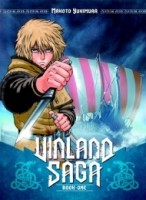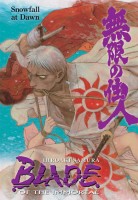 Creator: Hiroaki Samura
Creator: Hiroaki Samura
U.S. publisher: Dark Horse
ISBN: 9781616550981
Released: March 2013
Original release: 2009
Awards: Eisner Award, Japan Media Arts Award
Blizzard is the twenty-sixth volume in the English-language edition of Hiroaki Samura’s long-running, award-winning manga series Blade of the Immortal. Dark Horse originally released Blade of the Immortal by story arc rather than by number of chapters, so the volumes in the English-language release are slightly different from those in the original Japanese edition. Blizzard was published by Dark Horse in 2013 and is equivalent to the twenty-fifth volume of the Japanese series which was released in 2009. Blizzard takes place during the final major story arc of Blade of the Immortal and includes one of the series’ most important climaxes. I consider Blizzard to be a companion volume to the previous collection Snowfall at Dawn which leaves off partway through the battle between Shira and Manji. By the end of Snowfall at Dawn things aren’t looking at all good for Rin and Manji, so I was anxious to read Blizzard.
With Manji and Rin sunk beneath the pond’s freezing surface, Shira returns to the roadside where he left Magatsu incapacitated. Shira is not yet through with Manji, but he wants revenge against the young Ittō-ryū fighter as well and intends on making the most of their chance meeting. Magatsu is surprised to see Shira, too, having previously sent the sadistic killer plummeting from the top of a cliff during their last encounter. Shira once again finds himself interrupted when he is challenged by Meguro, one of Habaki’s shinobi. She has little hope of defeating Shira, especially now that he is semi-immortal, but her attack serves as a distraction. Shira isn’t aware of it, but back at the pond Meguro’s companion Tanpopo is doing all that she can to rescue and revive both Rin and Manji. At this point Manji is the only person who has even a slight chance of stopping Shira, but as Manji’s condition continues to deteriorate his success seems increasingly unlikely.
The beginning of Manji and Shira’s confrontation in Snowfall at Dawn was relatively subdued, focusing more on the psychological aspects of Shira’s attack and less on the physical combat. The conclusion of their battle in Blizzard is what I was really expecting and waiting for from their showdown. With two near immortals battling it out the damage that they inflict on each other is tremendous. Others can only look on astounded at the viciousness and brutality of the bloodbath occurring in front of them. Describing Manji and Shira’s final fight as intense would be putting it very mildly. At times it is difficult to see through all of the blood and guts as the two opponents literally rip each other apart. Samura’s artwork is unflinching and captures the entirety of their exceptionally violent battle as well as its bloody aftermath. Blizzard is extreme and gruesome and even those who make it through to the end of the volume barely survive.
While the duel between Shira and Manji is certainly the focus of Blizzard it isn’t the only important development in Blade of the Immortal to occur in the volume. I was happy to see Tanpopo and Meguro take on a more active role in the series. Up until this point in the manga they have generally been part of the series’ comedic relief—Meguro in particular frequently comes across as rather ditsy—but the women are shown to be quite capable martially in Blizzard. Another important development in the volume has to do with Renzō. His father, a member of the Ittō-ryū, was killed fairly early on by Manji in Blade of the Immortal. Since then Renzō has led a very difficult life, eventually becoming a broken and damaged young man partly due to the abuse he suffered at Shira’s hands and partly because he can’t forgive what happened to his father. His struggle isn’t over, but his story does begin to find a satisfying resolution in Blizzard.




